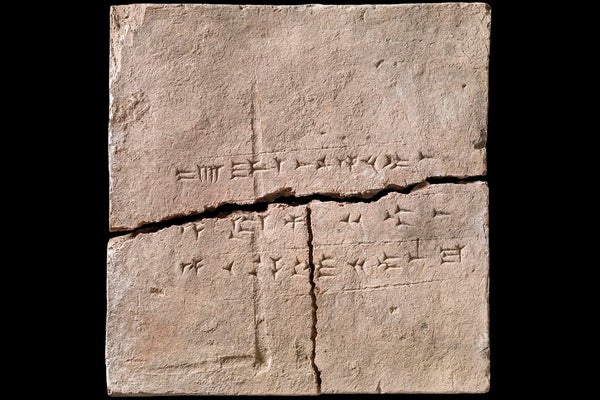December 1, 2023
2 min read
A chunk of a Mesopotamian palace revealed genes from dozens of ancient plants
By Susan Cosier

A clay brick from the National Museum of Denmark from which ancient DNA samples were derived.
Thousands of years ago people building a palace molded mud from beside the Tigris River into a brick, scooping up parts of nearby plants in the process. Researchers recently managed to tease discernible plant DNA from that brick, providing a rare look at what was growing in Mesopotamia (now part of Iraq) nearly three millennia ago, according to a study published in Scientific Reports.
“We were amazed when it turned out that we were actually able to extract ancient DNA from this clay material,” says co-author Sophie Lund Rasmussen, a biologist at Denmark’s Aalborg University. “This paper is primarily a proof of concept; we wanted to share the idea and the method with the world.”
Although scientists have extracted ancient DNA, or aDNA, from bones and lake sediments before, they hadn’t thought to try the existing techniques on clay bricks. Many bricks used to build historic structures don’t contain enough DNA for researchers to sequence, and bricks are often baked at high temperatures, which can degrade any plant DNA they might contain.
The newly studied brick, currently held by the National Museum of Denmark, had been sun-dried instead of fired. It was created between 883 and 859 B.C.E. and bears an inscription in the extinct Akkadian language reading “the property of the palace of Ashurnasirpal, King of Assyria.” A crack in the center of the brick allowed researchers to take tiny, better-preserved samples from deep inside.
The researchers sequenced the plant aDNA in the brick and found evidence of 34 taxonomic groups, including cabbage, heather, birch and cultivated grasses—new clues as to what people in this “cradle of civilization” consumed. Larger aDNA fragments, along with advances in DNA sequencing and machine learning (used to help interpret sequences), could allow researchers to detect distinct plant species.
“Now the real work starts, and we have to develop the method further and make it even more precise,” Rasmussen says. Her team’s efforts show how aDNA can be found in materials not generally thought to contain enough genetic substance to sequence, she says.
Ancient DNA sequencing could be used with other techniques for analyzing plant material to paint a fuller picture of the past, says Mads Bakken Thastrup, an archaeobotanist at Denmark’s Moesgaard Museum, who was not involved in the new study. Archaeobotanists currently examine evidence of ancient plant life by using chemical processes or imaging microscopes; extracting aDNA “could potentially be a valuable addition,” Thastrup says. “The findings are still a bit ‘low resolution,’ and the method will likely need further development before we can identify the plants at the species level. When that becomes possible, it will be truly interesting.”
>>> Read full article>>>
Copyright for syndicated content belongs to the linked Source : Scientific American – https://www.scientificamerican.com/article/scientists-sequence-dna-from-a-3-000-year-old-brick/































